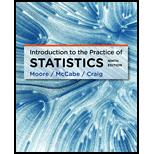
Concept explainers
(a)
Section 1:
To find: The degrees of freedom for group, for error, and for the total.
(a)
Section 1:
Answer to Problem 19E
Solution: The required degrees of freedom are
Explanation of Solution
Calculation: The variable I represents the number of groups and the variable N represents the total number of observations. According to the information given in the question
If DFG, DFE and DFT represent the group, error and total degrees of freedom respectively then they are calculated as shown below,
Section 2:
To find: The degrees of freedom for group, for error, and for the total.
Section 2:
Answer to Problem 19E
Solution: The required degrees of freedom are
Explanation of Solution
Calculation: The variable I represents the number of groups and the variable N represents the total number of observations. According to the information given in the question
If DFG, DFE and DFT represent the group, error and total degrees of freedom respectively then they are calculated as shown below,
Section 3:
To find: The degrees of freedom for group, for error, and for the total.
Section 3:
Answer to Problem 19E
Solution: The required degrees of freedom are
Explanation of Solution
Calculation: The variable I represents the number of groups and the variable N represents the total number of observations. According to the information given in the question
If DFG, DFE and DFT represent the group, error and total degrees of freedom respectively then they are calculated as shown below,
(b)
Section 1:
To explain: The Null and alternative hypotheses for cholesterol level in egg.
(b)
Section 1:
Answer to Problem 19E
Solution: The required hypotheses are,
Null Hypothesis: All the treatment means are equal.
Alternative Hypothesis: At least two of the treatment means differ significantly.
Explanation of Solution
Section 2:
To explain: The Null and alternative hypotheses for rating on a seven point scale.
Section 2:
Answer to Problem 19E
Solution: The required hypotheses are,
Null Hypothesis: All the three types of students gave same mean ratings.
Alternative Hypothesis: The average ratings of at least two sources of response differ significantly.
Explanation of Solution
Section 3:
The Null and alternative hypotheses for quiz score.
Section 3:
Answer to Problem 19E
Solution: The required hypotheses are,
Null Hypothesis: All the three groups of students have same mean scores.
Alternative Hypothesis: The mean score of at least two groups differ significantly.
Explanation of Solution
(c)
Section 1:
To find: The degrees of freedom for numerator and denominator of F statistic.
(c)
Section 1:
Answer to Problem 19E
Solution: The required degrees of freedom are
Explanation of Solution
Calculation: In F statistic, the degrees of freedom for numerator are given by
Thus, the F statistic is represented as,
Section 2:
To find: The degrees of freedom for numerator and denominator of F statistic.
Section 2:
Answer to Problem 19E
Solution: The required degrees of freedom are
Explanation of Solution
Calculation: In F statistic, the degrees of freedom for numerator are given by
Hence F statistic is represented as
Section 3:
To find: The degrees of freedom for numerator and denominator of F statistic.
Section 3:
Answer to Problem 19E
Solution: The required degrees of freedom are
Explanation of Solution
Calculation: In F statistic, the degrees of freedom for numerator are given by
Hence, F statistic is represented as,
Want to see more full solutions like this?
Chapter 12 Solutions
Introduction to the Practice of Statistics
 MATLAB: An Introduction with ApplicationsStatisticsISBN:9781119256830Author:Amos GilatPublisher:John Wiley & Sons Inc
MATLAB: An Introduction with ApplicationsStatisticsISBN:9781119256830Author:Amos GilatPublisher:John Wiley & Sons Inc Probability and Statistics for Engineering and th...StatisticsISBN:9781305251809Author:Jay L. DevorePublisher:Cengage Learning
Probability and Statistics for Engineering and th...StatisticsISBN:9781305251809Author:Jay L. DevorePublisher:Cengage Learning Statistics for The Behavioral Sciences (MindTap C...StatisticsISBN:9781305504912Author:Frederick J Gravetter, Larry B. WallnauPublisher:Cengage Learning
Statistics for The Behavioral Sciences (MindTap C...StatisticsISBN:9781305504912Author:Frederick J Gravetter, Larry B. WallnauPublisher:Cengage Learning Elementary Statistics: Picturing the World (7th E...StatisticsISBN:9780134683416Author:Ron Larson, Betsy FarberPublisher:PEARSON
Elementary Statistics: Picturing the World (7th E...StatisticsISBN:9780134683416Author:Ron Larson, Betsy FarberPublisher:PEARSON The Basic Practice of StatisticsStatisticsISBN:9781319042578Author:David S. Moore, William I. Notz, Michael A. FlignerPublisher:W. H. Freeman
The Basic Practice of StatisticsStatisticsISBN:9781319042578Author:David S. Moore, William I. Notz, Michael A. FlignerPublisher:W. H. Freeman Introduction to the Practice of StatisticsStatisticsISBN:9781319013387Author:David S. Moore, George P. McCabe, Bruce A. CraigPublisher:W. H. Freeman
Introduction to the Practice of StatisticsStatisticsISBN:9781319013387Author:David S. Moore, George P. McCabe, Bruce A. CraigPublisher:W. H. Freeman





